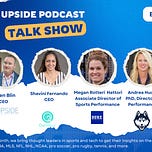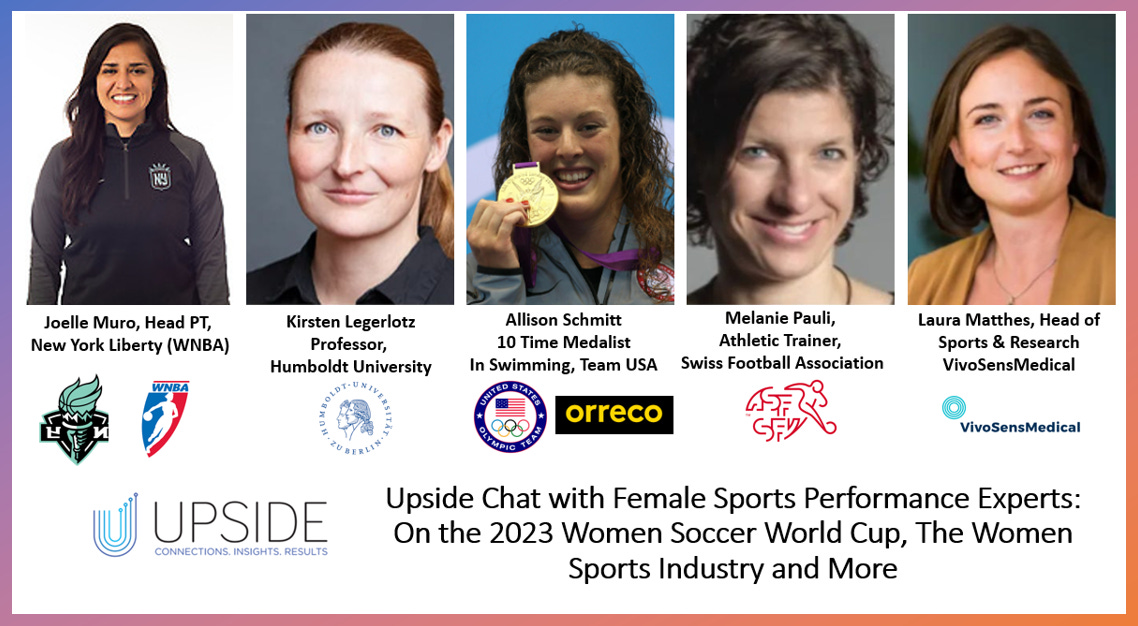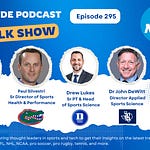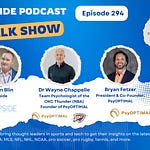Today as part of our continued effort to bring more awareness on female athletes, teams and associated trends related to female athletes, we have the honor to interview a group of female sports performance experts:
Megan Rottler Hattori, Associate Director of Sports Performance for Olympic Sports at Duke University. She is also the primary sports performance coach for the women’s soccer and volleyball teams.
Andrea Hudy, PhD, Director of performance at UCONN (University of Connecticut)’s women basketball team.
Shavini Fernando, CEO of OxiWear, Maker of the World's First Wearable Device for Continuous Real Time Monitoring of Oxygen During Motion.
Dr Christy Fernandez-Cull, PhD, CEO, DaVinci Wearables, an AI wearable device for women athletes and teams.
You can read the full transcript of the podcast interview with Megan, Andrea, Shavini and Christy located at the top of this blog post.
Here are the quotes from the interview with them:
Q1. Where do you see the biggest gap in how women’s teams are supported compared to men’s?
Andrea Hudy (UConn Women’s Basketball):
“The infrastructure within women’s athletics doesn’t exist as much as it maybe does in men’s sports. That was one of the main reasons I came back to UConn—to offer and create some of the infrastructures I saw in men’s sports. I’m hoping we’re doing that now. It's not just about equipment or data; it's about integrated systems—return-to-play, athletic management, communication between departments. That type of infrastructure can be lacking even on the men’s side sometimes, but it’s even more pronounced in women’s sports, especially when budgets are tight.”
Shavini Fernando (CEO, OxiWear):
“There’s a huge gap in data-driven research and tech access for female athletes compared to male athletes. Most of the decisions about training and recovery are based on data collected from male subjects. Hormonal cycles, physiological responses, and nutritional needs in women are different, yet most protocols are just repurposed from male-focused research. Even when companies like ours try to run studies to address this, it’s hard to get buy-in from teams—especially when male coaches don’t see the value or aren’t open to change.”
Megan Rottler Hattori (Duke Olympic Sports):
“I think one of the big barriers is lifestyle and pay. Being a mom and a coach is incredibly difficult. It’s not a nine-to-five, and when you're juggling practice, training times, and home life with young kids, something has to give. The disparity in pay makes you wonder, ‘Do I work to afford daycare or stay home and be with my kids?’ It’s not just about salaries—it’s about how our industry supports women holistically.”
Christy Fernandez-Cull (CEO, DaVinci Wearables):
“Access to resources is not equitable across divisions or genders. Division I schools aren’t the same as D2 or D3, and within each division, men’s teams tend to get more support. On top of that, only about 8–9% of performance research is focused on female athletes. When you talk about true support—research, funding, training environments—women are still playing catch-up. We’re just beginning to see investment in women’s performance facilities that include family-friendly spaces, mental wellness support, and women-specific health programming, but it’s only a start.”
Q2. If you had unlimited influence, what’s one thing you’d change today about how women’s teams are trained, funded, or supported?
Christy Fernandez-Cull:
“We need to reframe how we talk about female physiology. A lot of girls drop out of sports post-puberty because they feel isolated or confused about what’s happening in their bodies. There’s been a culture of ‘no pain, no gain,’ where you're supposed to push through cramps or hormone-related fatigue. We need to stop treating these things as weaknesses and start educating girls, coaches, and staff on how to harness female physiology as a strength. Education is the first domino—once people understand, they begin to invest.”
Shavini Fernando:
“We need to drastically reduce the pay gap for female coaches and create more flexible systems that account for the realities of being a woman—like raising children or balancing other responsibilities. That means rethinking job structures, travel, scheduling, and having dual-coach models so women don’t burn out trying to do the job the same way it’s been done for men. We also need more women in coaching and leadership, because female athletes are often more comfortable discussing things like mental health or menstrual cycles with someone who understands.”
Megan Rottler Hattori:
“Exposure matters. I didn’t grow up watching women’s sports because they weren’t on TV. I watched baseball—not softball—because that’s what was available. Today, girls can go on social media and see elite female athletes and coaches doing amazing things. That kind of visibility is powerful. If you see it, you can believe it. That’s how you build the next generation—not just of athletes, but of leaders, scientists, and innovators in sport.”
Q3. What are the root causes of salary disparities among women coaches, and how do we close the gap?
Andrea Hudy:
“At the end of the day, it’s about return on investment. Until organizations start seeing—or valuing—the ROI of women’s sports, salaries won’t rise. Are we generating the same revenue? Maybe not yet. But we haven’t had the same level of support or time to build that system. If this wave of investment and visibility keeps going, then yes—things will improve. But if momentum stalls, the gap will persist.”
Shavini Fernando:
“The problem starts at the top. The decision-makers are still predominantly men. That means budgets, tech allocation, staffing—they’re often biased toward the men’s teams, intentionally or not. Until we see more women in executive roles—more female athletic directors, GMs, CEOs—we won’t see real change. The system needs female voices at the table who understand and prioritize the unique needs of women’s sports.”
Christy Fernandez-Cull:
“It takes a community—both men and women—to change the narrative. You look at someone like Steph Curry, who’s been very vocal in supporting women’s sports and even wears gear from women-led companies. Or athletes like Caitlin Clark, who bring both performance and visibility. We need more allies like that—men who amplify our stories, help elevate the platform, and build economic momentum so that closing the gap becomes an imperative, not a nice-to-have.”
Q4. Why are there fewer sports tech solutions for women, and what can be done to accelerate innovation?
Shavini Fernando:
“It’s not that companies don’t want to build for women—it’s that we can’t do it in isolation. We reach out to teams wanting to co-create, run studies, test wearables—but we often get no response. Or the players don’t want to wear the devices. And if players don’t use the product, coaches can’t act on the data. Without participation, we can’t personalize or validate the product for women. That’s the reality.”
Andrea Hudy:
“We make technology part of the culture. In our learning lab, we don’t force athletes to wear anything. We invite them in, show them what insights the device can give them—how it helps their performance. When they understand the value and feel empowered, they buy in. That’s when compliance goes up. The education piece is critical—if they don’t see how it benefits them, they won’t use it.”
Christy Fernandez-Cull:
“There’s been a historic belief in venture capital that focusing on women—a ‘mere’ 50% of the population—wasn’t worth the investment. That mindset is finally changing. But it’s not just about building women-specific products—it’s about creating personalized, evidence-based solutions that reflect real-world variation. Two female athletes might have completely different physiological needs, so tech must evolve beyond the ‘average’ user and get smarter about gender, biology, and specificity. That’s how you build tools that actually move the needle.”
You may also like:
🔥Upside Chat with Female Sports Experts: Allison Schmitt (Olympic Champion),Mélanie Pauli (Swiss Football), Dr Christy Fernandez-Cull, PhD, CEO (DaVinci Wearables)
Today as part of our continued effort to bring more awareness on female athletes, teams and associated trends related to female athletes, we have the honor to interview a group of female sports performance experts:
🔥Upside Chat with Female Sports Experts: Joelle Muro (New York Liberty),Allison Schmitt (Olympic Champion),Laura Matthes (VivoSensMedical),Mélanie Pauli (Swiss Football),Kirsten Legerlotz (Humboldt)
Today as part of our continued effort to bring more awareness on female athletes, teams and associated trends related to female athletes, we have the honor to interview a group of female sports performance experts:













